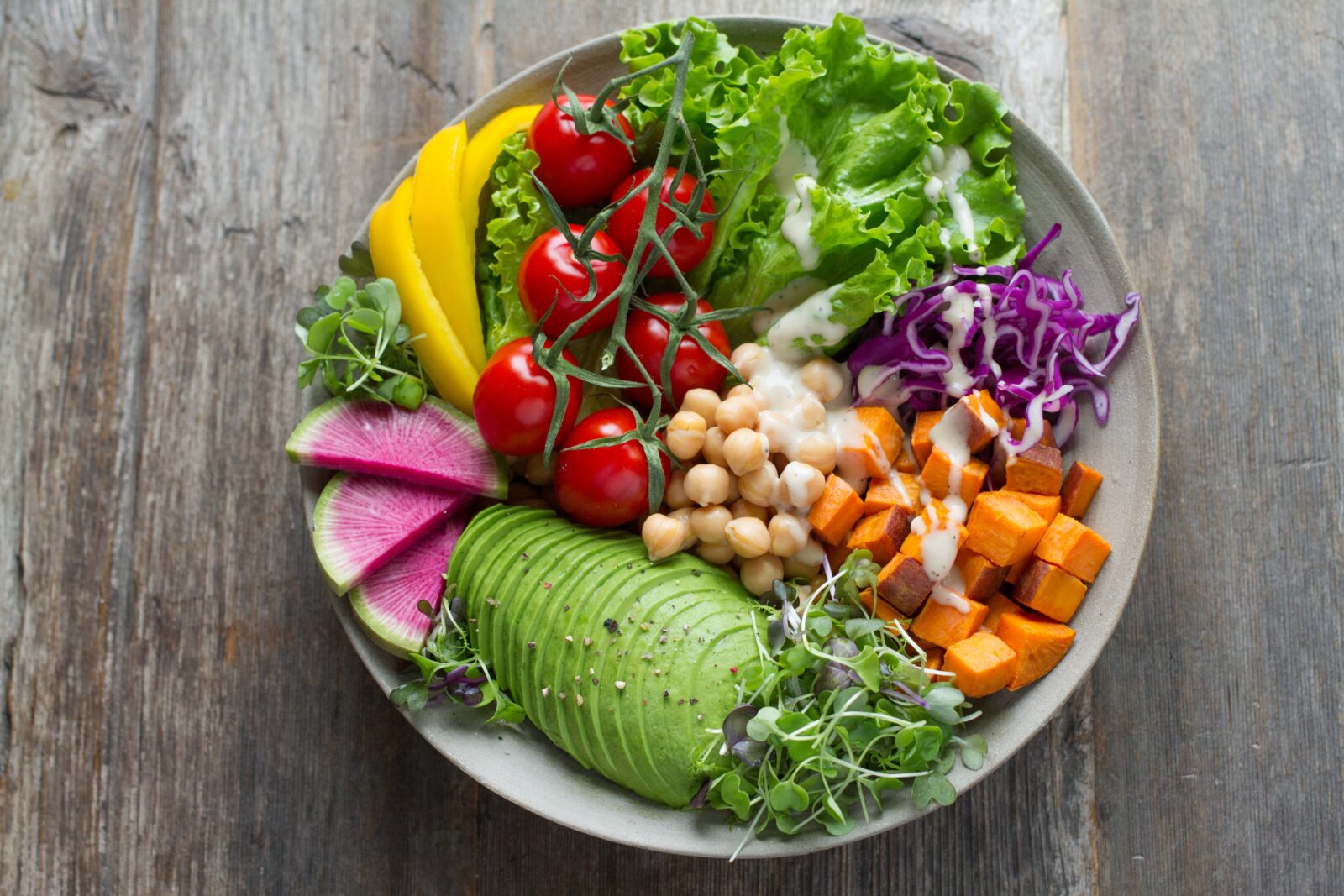On World Vegetarian Day, We Celebrate Tea Agriculture
Happy World Vegetarian Day!
While we are not vegetarians, we appreciate the gorgeous vegetables that come from our Boulder farmers. Chinese cooking centers around rice and vegetables. Thanks to so many thoughtful and savvy stewards of the land in our county, we savor greens, eggplant, squash, tomatoes, peppers, carrots, onions and so much more across the growing season. We also enjoy meat with our meals. A stir-fry with vegetables and bits of pork is classic.
Either way, we celebrate World Vegetarian Day for several reasons.
For one, anything that encourages people to eat more veggies is something we endorse.
But we also enjoy the day because like all vegetables, tea is an agricultural product. In other words, our working life revolves around an edible plant that grows on bushes around the world. Tea, of course, is vegetarian.
In fact, before people brewed tea leaves for a beverage, they considered the leaves an herb. Tea leaves were commonly used in cooking, and they still are around the world.
A favorite dish is Lahpet Thoke, a Burmese dish that includes fermented tea leaves. At least one restaurant in Colorado, Urban Burma in Aurora, sells this addictive salad. And the fermented tea leaves are key!
Nine Facts About Tea
- It takes about 2,000 leaves to make one pound of tea.
- People grow tea in the United States. Hawaii, South Carolina and Washington State have the largest tea farms. The U.S. League of Tea Growers says there are 60 tea farms in 15 states.
- The most productive areas for tea cultivation are between 2,000 and 7,000 feet in elevation in tropical areas that receive rain and mist. Lower elevations are best in more temperate climates.
- Tea artisans keep the bushes pruned to about three feet in height. If unattended, tea bushes can grow up to 40 feet in height.
- Oils in tea leaves impart most of tea’s flavor.
- Tea comes in two main varieties. Classic Camellia sinensis from China has small leaves. The Assam variety, from India, has larger leaves.
- Tea farmers grow bushes from cuttings or seeds, which take about four years to mature. Eventually the seedlings find a permanent spot on a plantation, where they are planted four feet apart.
- Tea bushes grown at high elevation are ready to begin harvests in five years. Low-elevation plants are ready in three years.
- Nearly all of the tea in the world is hand-picked. This is not the kind of agriculture that requires enormous mechanized harvesters. Experienced pickers can harvest about 160 pounds of tea a day. Those 160 pounds of fresh tea turn into 40 pounds of dry tea.
To celebrate our favorite plant on World Vegetarian Day, we offer ideas for vegetarian dishes with tea pairings.
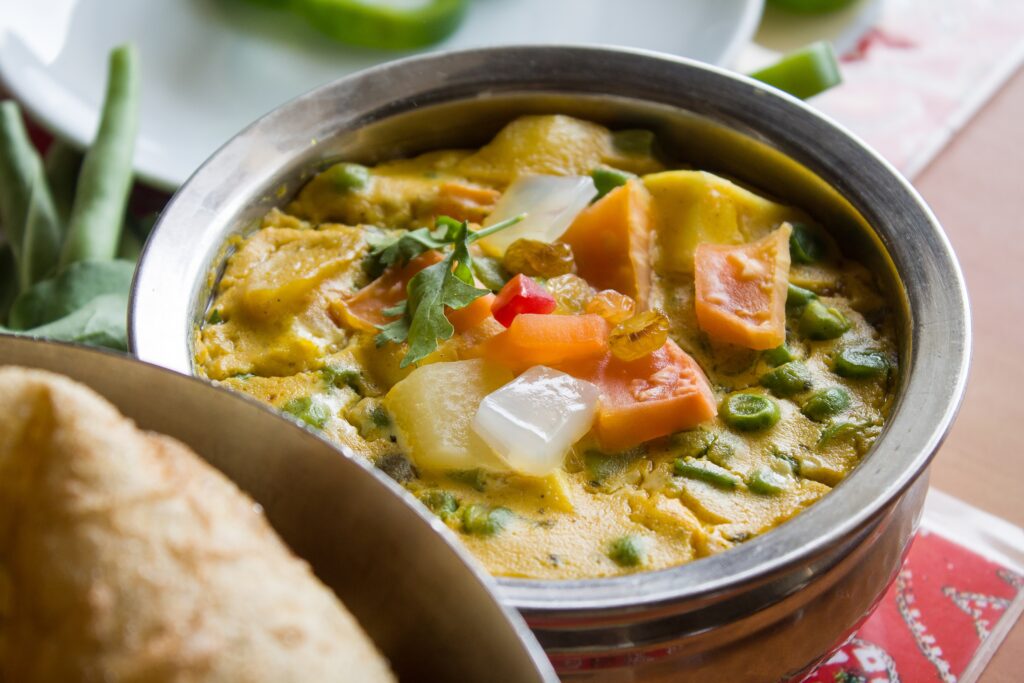
Tea Pairing: Curry and Bombay Chai
Archeologists have found evidence of curry production in India as far back as 4,600 years ago. This is a dish with staying power! And for good reason. What’s not to love about curry? As much of India is vegetarian, most of the country’s dishes arrive packed with vegetables, and no meat.
Iterations of curry flourish across the Indian subcontinent, as well as Pakistan and Bangladesh. But curry now is common across all of Asia, from Thailand to the Philippines. The Japanese love curry sauces over breaded and fried meats, as well as other dishes.
And curry has become part of the UK’s national identity. Every little town seems to have a curry shop, as well as a fish and chips spot offering curry sauces.
As curry is so packed with spice, we find that India’s national tea beverage, chai, is a perfect complement. It stands up to curry’s bold flavors. We carry 11 styles of chai, and enjoy them all with curry. However, we find our Bombay Chai, electric with flavors of ginger, cardamom, cinnamon, cloves and anise seed, pairs best with curry.
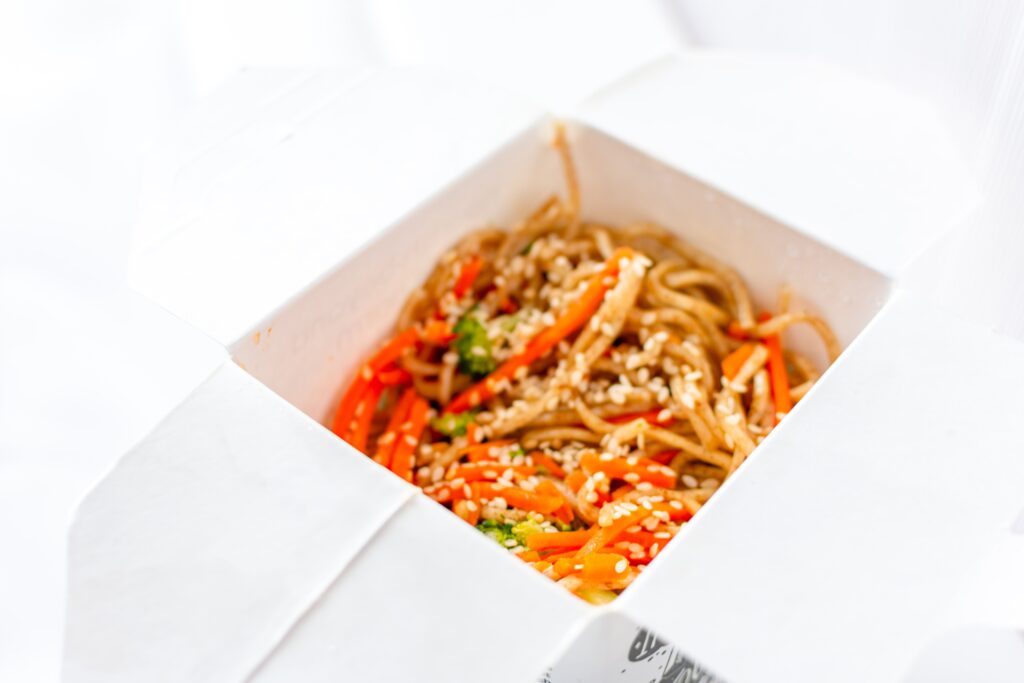
Tea Pairing: Sesame noodles & Jasmine Pearl
What Americans know as sesame noodles began in China as a Sichuan dish called Dandan noodles. The original dish involved a spicy sauce, fermented vegetables, pork and scallions over rice.
The yummy American-style dish probably got its start in New York’s Chinatown, when a cook replaced the spicy sauce with one made from sesame paste. At some point, peanut butter got added to the dish as well. To add even more complexity, with the addition of sesame paste Dandan noodles really becomes a variation of ma jiang mian, a noodle dish from Shanghai with sesame paste.
No matter the path of its evolution, we love a good bowl of bright sesame noodles. We like them spicy, too.
Given sesame noodles’ strong flavor, we like to pair the dish with our Organic Jasmine Pearl tea, our most popular style of jasmine tea.
The tea’s potent jasmine cuts through the dish’s fat — the sesame paste and peanut butter. It also gives the tea the muscle it needs to remain distinct as we munch on those sesame noodles.
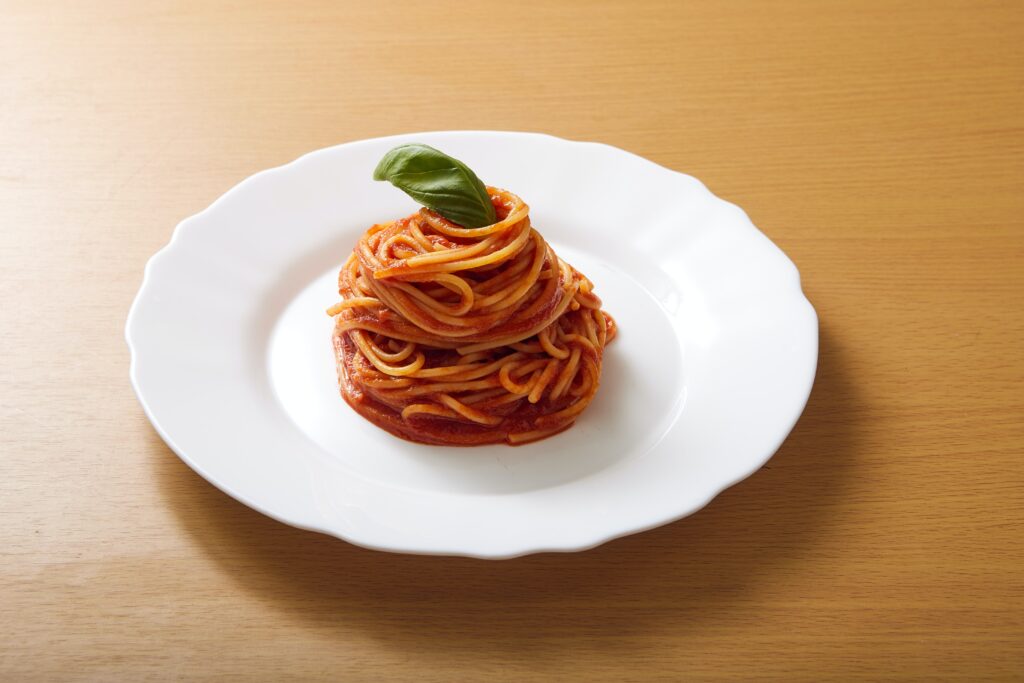
Tea Pairing: Spaghetti with Tomato Sauce & Passionfruit Oolong.
The Chinese invented noodles, and the country uses them in myriad dishes. We grew up with them, and adore well-executed Chinese-style noodles.
And then there’s the Italians. The Italians must have more noodle styles than the Chinese: spaghetti, orecchiette, fusilli, tagliatelle. It is estimated that Italians came up with 350 different styles of pasta.
Italian pasta is a beautiful thing. Rolling wheat flour, water and sometimes eggs into different shapes defines part of what it means to be Italian.
Spaghetti and tomato sauce, of course, is a true classic in the United States. It’s everywhere. In our view, it’s best when it involves basil.
Given the pasta’s faint wheat flavor, the tomatoes sweetness and the basil’s anise and floral perfume and flavor, we look for a tea with healthy oxidation that is leavened with fruit notes. Our Passionfruit Oolong is a natural choice.
The oolong in this tea undergoes extensive oxidation, meaning the tea is dark in color and reliably strong in flavor (tea doesn’t need to be dark to have strong flavor – some white teas are bold. But dark teas normally offer powerful flavor profiles). That power, however, is balanced with aronia berries, which are native to the American Midwest; cubes of mango; passion fruit; and rose petals.
The fruit balances the tea, and also complements the tomato in the sauce. And the rose petals pair beautifully with the basil.
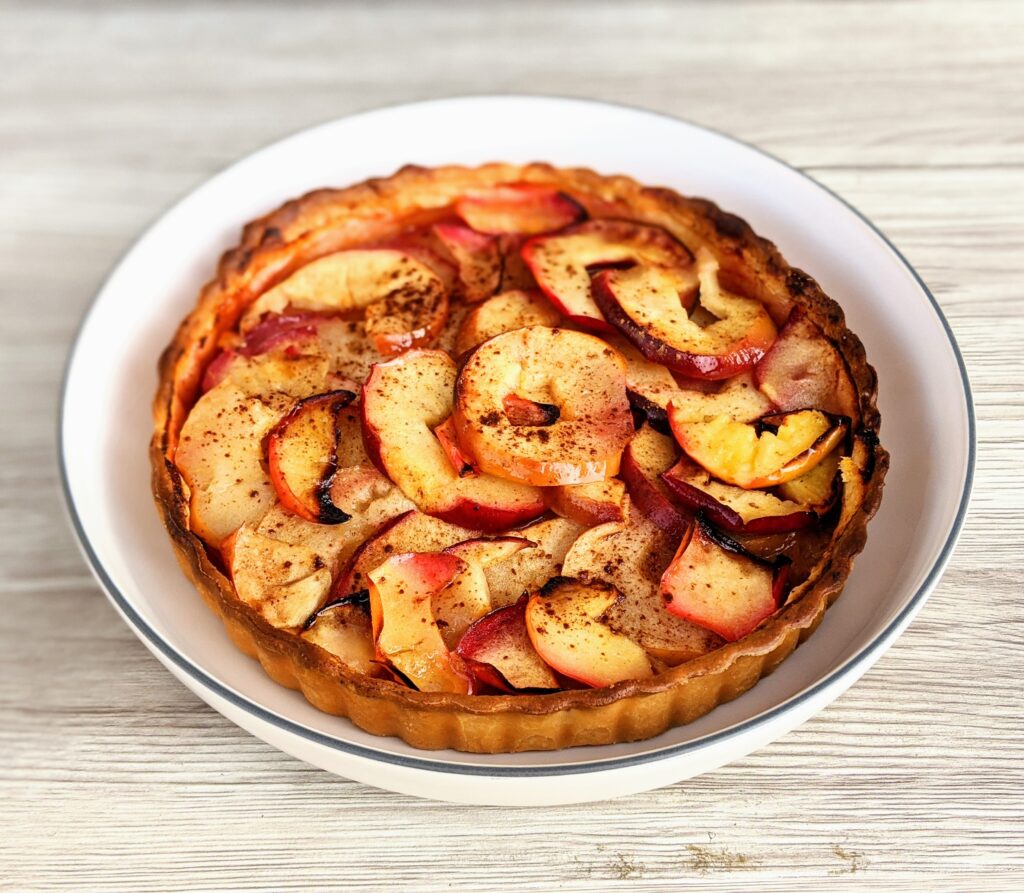
Tea Pairing: Apple Tart & Lady Earl Grey
April frosts slammed much of our great state’s fruit crops on the Western Slope. Not much in the way of cherries, apricots, plums or peaches this year. The frost zapped apple trees, too. But many more of their blossoms survived.
When we now hit the Boulder County Farmers’ Market in downtown Boulder on Saturdays, we encounter stands loaded with all manner of interesting apple variety: Galas, Fujis, Braeburns, Jonathans, Swiss Gourmet.
Now is the time to hold these apples in your hand and start taking bites. To slice them and add them to salads. To turn them into applesauce, and dried apple rings.
And how can an autumn pass without baked apple desserts? Apple pies, crumbles, crisps and cobblers all get the heart pounding. Our favorite might be a simple apple tart or galette — dough rolled thin, and covered with sliced apples, cinnamon, sugar and lemon juice. Edges of the dough folded over a few inches of the apple filling. Baked. Oh man. So good.
Nothing pairs with an apple dessert like our https://www.kuchatea.com/product/Lady%20Earl%20Grey/2311Lady Earl Grey black tea. Like all Earl Greys, the citrus fruit bergamot, which is mostly grown on Italy’s Calabrian coast, flavors the black tea. This version of Earl Grey also includes lavender and lemon. The combination is sublime.
Bon appetit!

